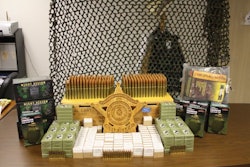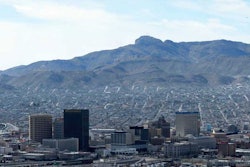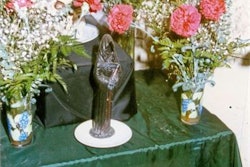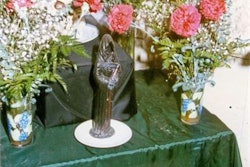On weekend nights, in the '70s and '80s, Southern California youth flocked to East Los Angeles. Hundreds, and sometimes thousands, of mostly Hispanic youth gathered in the main business district on Whittier Boulevard. Classically restored and customized automobiles cruised slowly, bumper to bumper, along the east-west boulevard.
These gatherings took on a party atmosphere that soon changed when Latino gang members began showing up. Since kids from across Southern California were attracted to Whittier Boulevard cruising, it was inevitable that rival gangs would encounter each other there. Many of the local ELA gangs considered this an invasion by foreign gangs. Gangs began appearing in larger groups with multiple vehicles, and armed with numerous weapons.
The sounds of honking horns and loud music were soon punctuated by gunfire. Each weekend, the local newspapers reported the ending of some poor Latino kid's life. Although most of these gang shootings seemed to be spontaneous, some of them were premeditated ambushes.
At this time and place, the 18th Street gang was only a few years old, but they had already become one of the city's0 largest gangs and were universally hated by most of the other Latino gangs. To establish themselves as "mas loco" (more crazy) gang members, 18th Street selected the parking lot of a hamburger stand as their killing ground. Adding insult to injury, this location was in traditional turf of the Mariana Maravilla gang.
Their ambush usually began with five attractive young women—18th Street gang home girls—parking a sedan along the north curb line of Whittier in front of the busy stand. These girls would honk their car horn and wave at passing low riders. They would get in and out of their vehicle dressed in their too-short skirts and halter tops. Sometimes they would mix with the hamburger-stand patrons. They would consistently flirt with any passing male gang members. They were excellent bait.
Parked in a nondescript van just north of the hamburger stand was "Goofy" and three other 18th Street gang members. They were armed and experienced shooters. These four were the teeth of the ambush trap.
While flirting with passing gang members, the girls would soon obtain the gang members monikers and gang affiliations. One of the females would then leave the other girls and their unaware targets and walk through the hamburger stand parking lot to the waiting van. She would report the gang affiliation and monikers of the possible targets to her homeboy Goofy. The four male 18th Street gang members would then decide if the targets were a "go" or a "no go."
When the target was selected, the van would load up. The female spotter would return to the other home girls and tell them to hold the target. The foolish victims with raging hormones would be coaxed to stop and park their vehicle next to the 18th Street girl's sedan.
The 18th Street van had a sliding door on the passenger side, so it circled the block and approached the victims west bound, pulling up parallel to the victims' vehicle. Suddenly the sliding door would open and the 18th Street gang members would fire their weapons down into the targeted vehicle and helpless victims. This was a successful ambush technique. By the time the police units would arrive, the van and the 18th Street home girls were long gone.[PAGEBREAK]
As statistics mounted of Whittier Boulevard's dead and wounded, Los Angeles County Sheriff's units tried to discourage the cruising ritual. We tried to get support for an anti-cruising ordinance from local businessmen and politicians. The only opposition came from Gloria Molina—a small time local politician who would later become a county supervisor. Over her objection, Whittier Boulevard was eventually closed to cruising.
The homicide detectives would eventually identify the 18th Street ambush tactics and arrest the ambush team, but not until many victims had fallen into the trap.
Hoyo Soto gang member Gilbert "Shotgun" Sanchez earned his "Shotgun" moniker in an impromptu ambush he set for an LAPD officer. He would later become a member of the Mexican Mafia prison gang. It began with a foot pursuit of "Shotgun" by the LAPD officer in the Hollenbeck Station area of Los Angeles. The original reason for the pursuit escapes my memory, but the LAPD officer chased him through a residential area, over fences and through yards.
At one point Sanchez had gained a few yards lead on the pursuing officer and leaped over a five-foot wall between houses. As the LAPD officer approached the wall running after Sanchez, he suddenly felt uneasy about jumping over the wall directly behind the fleeing Sanchez. Hesitating a few seconds, he looked over the wall several feet away from where Sanchez had jumped it. He saw Sanchez kneeling and pointing a sawed-off shotgun at the spot where he expected the pursuing LAPD officer to appear.
The LAPD officers were able to avoid this ambush and capture "Shotgun" Sanchez. This incident always came to my mind when I pursued gang members and I took extra care whenever I temporarily lost sight of a fleeing potential ambusher.
East Los Angeles gang member Jerome "Geronimo" Ortega was a revolutionary political radical and Mexican Mafia associate. Geronimo utilized a low-rider gang vehicle as his bait, hoping to be profiled and pulled over by any police patrol car. The teeth of this ambush were two open-bed pickup trucks which trailed behind the bait car. Two armed gang members rode in the bed of each pickup truck and the plan was for the trucks to flank the patrol unit and engage the officers in a surprise crossfire ambush.
Thankfully, this ambush went wrong when a police unit pulled behind the bait car, and a few seconds later a second unit pulled behind the pickup trucks. The second unit activated its lights to pull the trucks over for having passengers riding in the bed of the trucks (a violation of California's vehicle code). The broken-up ambush resulted in a pursuit and the arrest of the would-be ambushers.
Any suspect, who may feel cornered, may unexpectedly turn and ambush pursuing police officers. Situations for possible gang-ambush traps may spring from successful tactics practiced on gang rivals and adapted to spring on police officers. Sophisticated criminal gang members and members of radical groups may have received training in ambush tactics and tactical fireteam deployment to use against the police.
When confronting gang members, scan and assess the circumstances. Try to vary the usual pull-over procedure, and try not to be suckered into making a stop exactly where the suspect wants it. If the subjects seem too friendly (a baiting tactic) or they run just to get you to chase them, look for possible ambush signs and trust your warning instincts. Remember "Shotgun's" trick when you pursue gang members.
















